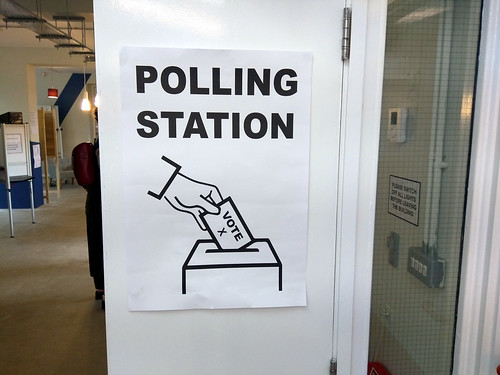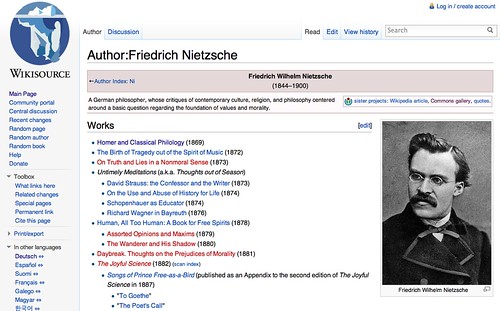
The tiny island of Anguilla accidentally snagged one of the internet’s most valuable domain names. How much is that worth? CC-licensed photo by Pete Markham on Flickr.
You can sign up to receive each day’s Start Up post by email. You’ll need to click a confirmation link, so no spam.
There’s another post coming this week at the Social Warming Substack on Friday at 0845 UK time. Free signup.
A selection of 9 links for you. Sunlit. I’m @charlesarthur on Twitter. On Threads: charles_arthur. On Mastodon: https://newsie.social/@charlesarthur. Observations and links welcome.
‘It’s quite soul-destroying’: how we fell out of love with dating apps • The Guardian
Robyn Vinter:
»
Dating apps, often referred to as simply “the apps”, have become such a ubiquitous part of the modern dating scene that it can be difficult to remember how connections were made before they popped up in the early 2010s. Having evolved out of desktop dating sites like eHarmony and Match.com, which were perhaps unfairly characterised as lonely hearts services for people struggling to make acquaintances in real life, the likes of Tinder, Grindr, Bumble and Hinge have become, for some, the only way to meet people.
But the sand appears to be shifting once again. More than a decade on, users are abandoning their profiles in search of a better way of meeting like‑minded people. The most up-to-date figures show the world’s most popular dating app, Tinder, saw its users drop by 5% in 2021, while shares in both Bumble and Match Group, which owns Tinder, have declined steadily over the last couple of years.
It is a problem that seems likely to get worse for those companies, as more than 90% of gen Z feel frustrated with dating apps, according to youth research agency Savanta.
“The apps are algorithmic doom barrels,” says Dylan Freeman-Grist, a 29-year-old living in Toronto, Canada. He recently split from a long-term partner and even what he describes as a sense of forboding, “that I’m fated to end up alone”, was not enough to drive him back to dating apps. The spam, bots and fake accounts are tough enough to contend with, he says, and that’s before all the issues with being assessed for attractiveness based on six pictures and a few lines of text.
“It does not matter how handsome or beautiful or charming you are, there is this underlying tension that you are 10 swipes away from a person that outranks you on the conventional beauty and charisma scale. It’s enough to make you feel all the insecurities that you haven’t needed to swallow since you were a teenager and a whole ream of new adult ones,” he says.
But with the apps being so embedded in the culture of modern dating, where else can single people turn to meet the love of their life, or even have a quick fling?
«
“Doom barrel” is perfect.
unique link to this extract
A tiny supercritical carbon dioxide turbine for 10,000 homes • Clean Technica
Tina Casey:
»
The familiar steam turbines in wide use at power plants today are based on 19th-century technology. They typically range in size from less than 100 kilowatts to more than 250 megawatts, depending on the use case. When used to generate electricity in a central power plant they are massive beasts, the size of a bus or larger.
Supercritical carbon dioxide turbines are different. They don’t deploy steam as a working fluid. Instead, they use a concentrated form of carbon dioxide — sCO2 for short — that hovers somewhere between a gas and a liquid.
The Energy Department anticipates that new supercritical carbon dioxide turbines can shave energy consumption at power plants by 10%, but that’s just for starters. They have a much smaller footprint than their steam-driven cousins, resulting in manufacturing efficiencies all along the supply chain.
By way of comparison, the Energy Department calculates that a 20-meter steam turbine would shrink down to one meter if replaced with an sCO2 turbine.
“Above the critical point, CO2 does not change phases [that is, change from gas to liquid]. Instead, it undergoes a change in density in even small shifts in temperature and pressure,” the Energy Department explains. “This property allows a large amount of energy to be extracted at a high temperature, using equipment that is relatively compact.”
“The sCO2 turbines may be an order of magnitude smaller than today’s utility-scale combustion or steam turbines,” they emphasize.
Like steam turbines, supercritical carbon dioxide turbines are fuel agnostic. The Energy Department anticipates deploying them in coal and gas power plants as energy efficiency upgrades.
«
sCO2 turbine thermal efficiency can be around 45%, which compares with about 32% for steam turbines; that makes the sCO2 turbines about 40% more efficient. Good numbers.
unique link to this extract
I can hear you fine. Is it rude that i’m still wearing AirPods? • WSJ
Nicole Nguyen tried out the new “Conversational Awareness” setting on the latest AirPods Pro – for an entire day:
»
I’m sensitive to sound and easily distracted. Living in a metropolis and working in an open office don’t help. Noise-cancelling earbuds have been a saviour.
There are concerns, however, that constantly blocking out the world limits connection and serendipity. I think this speech-detection feature, which dips you in and out of your environment, is a good compromise.
Still, there remains a larger question about the etiquette of wearing AirPods in the real world. At a bakery about a week ago, I got nervous about ordering with AirPods still in my ears, until I saw another person with earbuds doing it. It felt OK because it was such a brief interaction.
It felt more rude to wander around my office, chatting people up with my AirPods in. Maybe even worse: engaging with a server while ordering a sit-down solo lunch. When my editor saw a colleague on the walk to his train station, he could barely say hi before taking his own AirPods out. For anyone over the age of 25, it just feels weird to talk to people while wearing them.
When you wear AirPods, there’s still ambiguity for the other person. Are you giving that person undivided attention? Are you listening to something? Nothing signals to them that you can even hear what they say.
“Earbuds are a way to let someone know you are not interested in talking to them on a flight, subway, train or anywhere in public,” said Diane Gottsman, who runs the Protocol School of Texas, a corporate-etiquette training company. So while it’s fine to wear them in the office to avoid unnecessary chitchat, you need to “take them off when walking through the hallways,” Gottsman added.
More people with hearing loss use AirPods and other earbuds as aids. For them, there should be an exception. Explain to colleagues or loved ones that the buds are helping you understand the conversation.
«
First we shape our tools, and then they shape us. And they shape our social norms and etiquette.
unique link to this extract
Sundar Pichai acknowledges Google search default deals were ‘very valuable’ • FT
Stefania Palma:
»
Sundar Pichai conceded that agreements making Google’s search engine the default on smartphones and browsers can be “very valuable”, as the Alphabet chief executive took the witness stand in the most significant monopoly trial in 25 years.
Pichai told the court on Monday that deals the company has struck with technology groups, smartphone makers and mobile telecoms companies — worth billions of dollars annually — when “done correctly . . . can make a difference”.
He added: “There are scenarios where defaults are very valuable,” and that users also stand to benefit. The US government has accused Google of illegally maintaining a monopoly by paying for agreements that ensure its search engine appears prominently on smartphones and browsers. The group has denied wrongdoing, arguing it is facing tough competition and that its market share is the result of the strength of its product, which consumers choose to use.
The Department of Justice had previously said that Google spends upwards of $10bn a year on default agreements, but a top executive revealed in testimony Friday that the group paid $26.3bn on such deals in 2021.
Pichai is the most high-profile witness to take the stand in the landmark trial, which has entered its seventh week, since Microsoft chief executive Satya Nadella’s testimony earlier this month.
Prosecutors claimed Google was using the same practices that it had criticised when Microsoft used them in the early 2000s. DoJ lawyer Meagan Bellshaw on Monday cited a letter from Google sent as Microsoft was gearing up to launch a new version of its Internet Explorer browser in the 2000s. Google threatened legal action because Microsoft’s search engine would become the default in the new browser, and users would not be prompted to make a choice.
Under other agreements to make Google’s search engine the default in which it shares revenue from those queries, Google prohibits its partners from prompting users to select their own default search engine.
«
What’s in a domain name: The meaning of URL suffixes • Rest of World
Amy Thorpe:
»
Take Anguilla, for instance. A British territory in the Caribbean, there are fewer than 20,000 people on the tiny island. It doesn’t seem like the sort of place that would benefit from the artificial intelligence wave sweeping the tech world — except Anguilla’s country code top-level domain (ccTLD) is .ai, an irresistible address for AI startups.
“I knew way back that [.ai] could end up being used for artificial intelligence, that it could be valuable someday. But it was a question of when, right?” Vincent Cate, president at DataHaven.Net Ltd, which handles sales of the .ai domain for the Anguillan government, told Rest of World. “It really, really took off November [30, 2022], when ChatGPT came out. The sales have gone up a lot since then.”
The rewards from selling web addresses are considerable: Cate estimates the revenue generated by Anguilla’s .ai domain — around $3m per month — currently accounts for around a third of the government’s monthly budget. Following a deal with GoDaddy in 2022, some reports said Tuvalu could make $10m per year from the .tv domain — one-sixth of its GDP. That revenue has allowed Tuvalu to pave its roads, expand electricity access for its residents, and even pay its first annual United Nations membership in 2000.
Landing the rights to .tv and .ai has proved a gold mine for Tuvalu and Anguilla — but how did they get these specific addresses to begin with?
«
The answer is: historical accident. But it’s a worthwhile read.
unique link to this extract
X says it is worth $19bn, down from $44bn last year • The New York Times
Ryan Mac:
»
X, the company formerly known as Twitter, handed out stock grants to employees on Monday that showed it was worth about $19bn, down about 55% from the $44bn that Elon Musk paid to buy the firm a year ago, according to internal documents seen by The New York Times.
Mr. Musk paid $54.20 a share to buy Twitter just over a year ago. The tech billionaire has since said he overpaid for the social network. In March, he wrote in an email to workers that he believed the company was worth $20bn, calling it “an inverse start-up.”
In the paperwork for the new stock grants, X said the equity would be offered at $45 a share in the form of restricted stock units, which employees can earn over time. Employees will still be paid in cash in the amount of $54.20 for any outstanding shares that were granted to them under previous management, the company said.
It’s unclear why the share price has not dropped by the same percentage as the company’s valuation, though X could have altered the amount of shares outstanding. Fortune earlier reported on the valuation. A spokesman for X did not return a request for comment.
In his year of owning Twitter, Mr. Musk has overhauled the company and the social media platform. More than 80% of its 7,500 employees have either quit or been laid off. He has changed the service’s verification process, as well as content-moderation rules. Advertising, the company’s main source of revenue, was down in the United States by almost 60% this summer. Mr. Musk also loaded the company with billions of dollars in debt to help pay for the acquisition.
In November, he famously made a joke about spending to buy a social media company, asking, “How do you make a small fortune in social media? Start out with a large one.”
«
They laughed when he said he’d get into comedy. They’re not laughing now. Anyway, for those shares to vest, Twitter would have to be worth over $36.5bn, or nearly double what it is now. There’s also a good thread on, er, Threads by Zoe Schiffer about other things in the document.
unique link to this extract
Reddit is killing blockchain-based Community Points • TechCrunch
Morgan Sung:
»
Reddit is winding down Community Points — the blockchain-based “internet points” program designed to reward creators and developers — in favor of prioritizing rewards programs that are less difficult to scale.
“Though we saw some future opportunities for Community Points, the resourcing needed was unfortunately too high to justify,” Reddit’s director of consumer and product communications Tim Rathschmidt told TechCrunch. “The regulatory environment has since added to that effort. Though the moderators and communities that supported Community Points have been incredible partners — as it’s evolved, the product is no longer set up to scale.”
«
Who would have guessed that a blockchain-based system wouldn’t scale, eh.
unique link to this extract
Inside a $30m cash-for-Bitcoin laundering ring in the heart of New York • 404 Media
Joseph Cox:
»
For years, a gang operating in New York allegedly offered a cash-for-Bitcoin service that generated at least $30 million, with men standing on street corners with plastic shopping bags full of money, drive-by pickups, and hundreds of thousands of dollars laid out on tables, according to court records.
The records provide rare insight into an often unseen part of the criminal underworld: how hackers and drug traffickers convert their Bitcoin into cash outside of the online Bitcoin exchanges that ordinary people use. Rather than turning to sites like Coinbase, which often collaborate with and provide records to law enforcement if required, some criminals use underground, IRL Bitcoin exchanges like this gang which are allegedly criminal entities in their own right.In a long investigation by the FBI involving a confidential source and undercover agents, one member of the crew said “that at least some of his clients made money by selling drugs, that his wealthiest clients were hackers, and that he had made approximately $30 million over the prior three years through the exchange of cash for virtual currency,” the court records read.
The investigation started in around April 2021 when the FBI identified a vendor on multiple dark web marketplaces who offered a service to ship cash via the US Postal Service in exchange for Bitcoin or other cryptocurrency. Fast forward to this February, and law enforcement arrested an individual who had been mailing packages of cash from a post office in Westchester County, New York, on behalf of the gang, the court records say. This person became a confidential source, known as CS-1 in the documents, with the hope of consideration of their cooperation come the time of sentencing.
«
The story includes photos from the court records, which show that yup, it’s like The Wire, but with money instead of drugs.
unique link to this extract
Meta will charge up to €12.99 for ad-free versions of Facebook and Instagram in Europe • The New York Times
Adam Satariano and Christine Hauser:
»
To protect people’s privacy, the European Court of Justice, the highest court in the EU, effectively barred Meta in July from combining data collected about users across its platforms — including Facebook, Instagram and WhatsApp — as well as from outside websites and apps, unless it received explicit consent from users. That came after a January decision by EU regulators to fine Meta 390 million euros for forcing users to accept personalized ads as a condition of using Facebook.
In its July decision, the European Court of Justice indicated that offering a subscription service in Europe may be a way to comply with the judgment, Meta said. A subscription can allow users to access the platforms without having their personal data used to sell ads.
“We respect the spirit and purpose of these evolving European regulations, and are committed to complying with them,” the company said in a statement announcing the new paid tier on its website.
Meta added that while it was committed to keeping people’s information private and secure, it believed in an “ad-supported internet” that provides people with personalized products and services, while also allowing small businesses to reach potential customers.
Max Schrems, a privacy activist in Austria whose legal challenges targeting Meta helped lead to the product changes, said the subscription offerings do not comply with the EU data privacy law, known as the General Data Protection Regulation. He vowed to challenge it in court.
“If we move to a pay-for-your-rights system, it will depend on how deep your pockets are if you have a right to privacy,” Mr. Schrems said. “We are very skeptical if this is compliant with the law.”
«
I wrote about this on the Social Warming Substack a couple of weeks ago: the price Meta is asking is miles more than it actually makes from you via ads. (Plus Meta’s financials contain terrible chart crime.)
unique link to this extract
| • Why do social networks drive us a little mad? • Why does angry content seem to dominate what we see? • How much of a role do algorithms play in affecting what we see and do online? • What can we do about it? • Did Facebook have any inkling of what was coming in Myanmar in 2016? Read Social Warming, my latest book, and find answers – and more. |
Errata, corrigenda and ai no corrida: none notified









